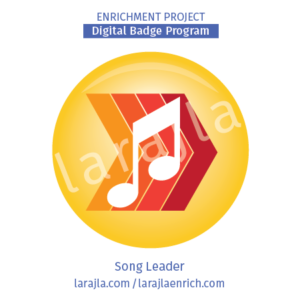 Everyone has a song they want to sing. Someone needs to reign in the chaos. Why not you?
Everyone has a song they want to sing. Someone needs to reign in the chaos. Why not you?
Steps
Prepare
1. Lead and sing.
While most song leaders lead all the songs at an event, you might share responsibility with others. Even if you do not plan on leading, be sure to get copies of all the songs others will be presenting at your event. This way, if someone can’t make it, you have the materials for the event.
2. Song list.
If you are working an event, meeting or class, make sure you have a song list ready to go. If you’re following a theme, doing a specific type of event or even working with a specific age group, take that into consideration when you’re creating a song list. Include the lyrics, movements and any notes you want to have on-hand.
NOTE: Keep the items you use in either a digital file or a printed folder so you have them available if you plan to do a similar event in the future.
3. Change words.
As songs are shared, the words are frequently changed. If you find lyrics that are not what you normally use, adjust the materials you find online to match what you already know. You do not want to be tripping over unfamiliar words or turns of phrase while you’re singing with others.
4. Note cards.
Don’t want to deal with full sheets? Create note cards to help cue you to words or actions. You can design these for your own use or for others helping you.
Take one of your songs and create cards. Try doing the song with and without them. Decide if you need to provide the cards to your participants as well.
You may want to come up with a way for your audience to participate with the cards like handing them out so each person has a card and leads the action. This gives your audience a sense of ownership and encourages cooperation.
5. Practice.
While this step sounds like a “no brainer”, don’t convince yourself that you’ve sung your song(s) enough that you’ll remember the lyrics, tune and actions on the spot. I have had people ask me to go over a song I previously shared only to forget a part. It’s very confusing for your audience if you’re adding things in that you “forgot” and backtracking to that spot.
Watch yourself in the mirror when you are practicing your songs. If you don’t like what you see, change it before you share with your audience.
6. Record.
To allow you to practice, recordings help. This may be a file you downloaded from YouTube, a recording you made at an event or even yourself singing the song. Explore creating and playing recordings of songs.
7. Song sheets.
Prepare song sheets for your audience. Depending on the age of your audience, you may want to hand these out before you start or afterwards. Giving the sheets out before starting may help your audience follow the words. They may spend more time looking at the pages than paying attention to you while you’re showing the gestures or working on the tune that goes with the words. This choice will depend on you.
Lead Songs
8. Confident.
If you’re excited about sharing a song, they’ll be excited too! Be sure to be loud so everyone can hear you and clear in your instructions. Your audience will pick up on your emotions. Smile. Relax. Have fun! If you’ve practiced and made your cards, you’ll look more confident and that will also be conveyed to your audience.
9. Song they know.
Starting out with a success boosts their confidence. They’ll be more willing to try new songs if they’re enjoying themselves.
10. Signals.
Create signals to stand up, start singing, etc. People who are not paying close attention or are too far away to see your subtle physical clues will appreciate you raising your hands above your head to ask them to stand up.
11. Keep it slow.
When you’re teaching a completely new song, keep it slow and repeat your actions enough so that everyone gets them. If you have someone struggling, pair them up with someone who grasps the song and actions quickly.
12. Old favorites.
If your audience has a favorite, keep it handy in case someone really wants to do it. You may be tired of singing a particular song, but they may not be.
13. Share the lead.
If someone knows a song and wants to share, step back. Let them take the lead. Don’t confuse your audience with multiple leaders. Instead, focus on your group and the person leading. You’ll be able to tell by their body language when it’s time for you to take back the lead.
Always thank other volunteers for helping out. If the song is not one you have, ask your volunteer for a copy of the song or a place you can find it on the Web so you can include it in your personal songbook.
14. Contact information.
Make sure you give your audience a way to contact you. They may try to do an action song on their own and need encouragement, may have lost materials, etc. They may even want you to come and sing with them again!
Also, getting their contact information allows you to forward on any additional recommendations made by the audience or share dates with them when you’ll be singing again.
Supplements
SUPP_Song Leader_2in_12up_larajla
- Avery 2.5” round label printable, 12 up
SUPP_Song Leader_Checklist_larajla
- Badge checklist
Sites to Explore
- www.riseupandsing.org/singing/songleading
- www.grace4all.com/song-leading
- greenbay.younglife.org/Documents/How to lead a song.pdf
- extension.psu.edu/programs/4-h/members/projects-resources/healthylifeed/health/TipsLeadingSongs.pdf
- www.4-hontario.ca/uploads/userfiles/files/1.0%20tips%20for%20song%20leaders.pdf
- gsuniversity.girlscouts.org/resource/song-leading-workshops/song-leading-mini-workshop-for-adults-brownies
- www.girlscoutsoc.org/content/dam/girlscoutsoc/documents/DC_Songs_games_hikes_swaps_ceremonies.pdf
Get the infographic here > larajla blog post
Get the PDFs of the badge program / supplements here > Full badge PDFs